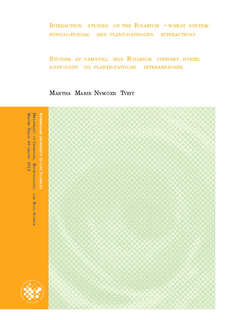Interaction studies of the Fusarium-wheat system : fungal-fungal and plant-pathogen interactions
Master thesis

View/
Date
2012-10-03Metadata
Show full item recordCollections
- Master's theses (KBM) [890]
Abstract
Abstract
Different Fusarium species are the cause of Fusarium head blight in wheat and have been
regarded as one of the most devastating crop pathogens in the world. Some Fusarium can
produce mycotoxins that can contaminate grain and be harmful when ingested by humans and
animals. Different species of Fusarium can occur on the same wheat ear, where they possibly
can have an effect on each other. In this study, three different Fusarium species (Fusarium
avenaceum, F. culmorum and F. graminearum) were inoculated on wheat, alone or in pairwise
combinations. DNA from each of the species were isolated from infected wheat and quantified to
see if growth was influenced by interaction in young wheat and wheat at the ripening stage.
Expression levels of the two mycotoxin related genes Esyn (enniatin production in
F. avenaceum) and Tri1 (deoxynivalenol production in F. graminearum) were investigated by
real-time quantitative PCR in young wheat. The amount of the mycotoxins enniatins and
deoxynivalenol were measured by gas chromatography–mass spectrometry in wheat at the
ripening stage. Signs of interaction between F. avenaceum and F. graminearum were
demonstrated, both in respect to DNA quantity and mycotoxin production. The upregulated Tri1
in F. graminearum in the initial stages is in agreement with previous knowledge that DON is
necessary for F. graminearum establishment in wheat.
To further investigate the possible interaction between F. graminearum and F. avenaceum, an in
vitro culture plate study was done. A F. graminearum mutant constitutively expressing red
fluorescence protein and expressing green fluorescence protein (GFP) when inducing Tri5, a
gene involved in the toxin pathway, was used. The F. graminearum mutant was together with
F. avenaceum co-inoculated on plates and investigated in confocal laser scanning microscopy
(CLSM) every third hour. No obvious signs of interaction were seen, possibly because of the
relatively short time span. F. graminearum did however grow much faster than F. avenaceum,
revealing its more aggressive nature.
F. langsethiae is a relatively newly discovered species, often found in barley and oat, but seldom
in wheat. Why this specie is rarely found in wheat is still unknown. Its interaction with wheat is
also poorly understood. Two inoculation experiments on wheat were done: 1) In a detached leaf
assay (DLA) conidial suspensions of a F. langsethiae mutant constitutively expressing GFP
(F. langsethiae GFP) were inoculated on wheat leaves. 2) A greenhouse experiment where wheat
heads were inoculated with conidial suspension of F. langsethiae at anthesis. Infection in leaves
from DLA were later measured and investigated with CLSM. Hyphal assemblies around stomata
of the plant were seen repeatedly, indicating that stomata could be the entering point for
F. langsethiae infection on wheat leaves. Scanning electron microscopy of the florets from the
greenhouse experiment showed that F. langsethiae was able to infect the outer layers of the
floret. When growing directly on the caryopsis, however, hyphae where lysed, possibly by
defence mechanisms from the host.